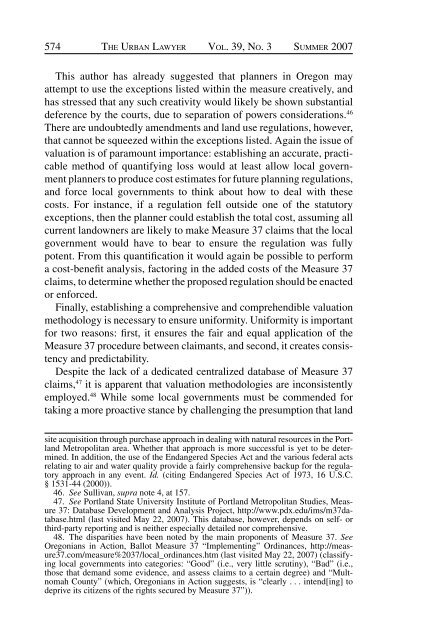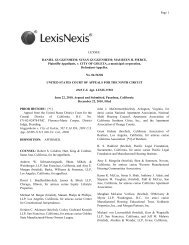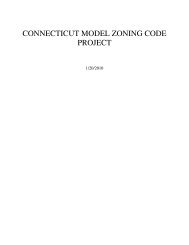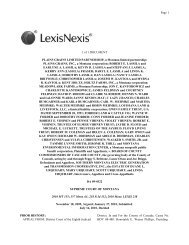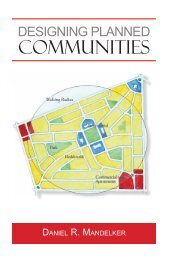Through a Glass Darkly: Measuring Loss Under ... - Land Use Law
Through a Glass Darkly: Measuring Loss Under ... - Land Use Law
Through a Glass Darkly: Measuring Loss Under ... - Land Use Law
Create successful ePaper yourself
Turn your PDF publications into a flip-book with our unique Google optimized e-Paper software.
574 THE URBAN LAWYER VOL. 39, NO. 3 SUMMER 2007<br />
This author has already suggested that planners in Oregon may<br />
attempt to use the exceptions listed within the measure creatively, and<br />
has stressed that any such creativity would likely be shown substantial<br />
deference by the courts, due to separation of powers considerations. 46<br />
There are undoubtedly amendments and land use regulations, however,<br />
that cannot be squeezed within the exceptions listed. Again the issue of<br />
valuation is of paramount importance: establishing an accurate, practicable<br />
method of quantifying loss would at least allow local government<br />
planners to produce cost estimates for future planning regulations,<br />
and force local governments to think about how to deal with these<br />
costs. For instance, if a regulation fell outside one of the statutory<br />
exceptions, then the planner could establish the total cost, assuming all<br />
current landowners are likely to make Measure 37 claims that the local<br />
government would have to bear to ensure the regulation was fully<br />
potent. From this quantification it would again be possible to perform<br />
a cost-benefit analysis, factoring in the added costs of the Measure 37<br />
claims, to determine whether the proposed regulation should be enacted<br />
or enforced.<br />
Finally, establishing a comprehensive and comprehendible valuation<br />
methodology is necessary to ensure uniformity. Uniformity is important<br />
for two reasons: first, it ensures the fair and equal application of the<br />
Measure 37 procedure between claimants, and second, it creates consistency<br />
and predictability.<br />
Despite the lack of a dedicated centralized database of Measure 37<br />
claims, 47 it is apparent that valuation methodologies are inconsistently<br />
employed. 48 While some local governments must be commended for<br />
taking a more proactive stance by challenging the presumption that land<br />
site acquisition through purchase approach in dealing with natural resources in the Portland<br />
Metropolitan area. Whether that approach is more successful is yet to be determined.<br />
In addition, the use of the Endangered Species Act and the various federal acts<br />
relating to air and water quality provide a fairly comprehensive backup for the regulatory<br />
approach in any event. Id. (citing Endangered Species Act of 1973, 16 U.S.C.<br />
§ 1531-44 (2000)).<br />
46. See Sullivan, supra note 4, at 157.<br />
47. See Portland State University Institute of Portland Metropolitan Studies, Measure<br />
37: Database Development and Analysis Project, http://www.pdx.edu/ims/m37database.html<br />
(last visited May 22, 2007). This database, however, depends on self- or<br />
third-party reporting and is neither especially detailed nor comprehensive.<br />
48. The disparities have been noted by the main proponents of Measure 37. See<br />
Oregonians in Action, Ballot Measure 37 “Implementing” Ordinances, http://measure37.com/measure%2037/local_ordinances.htm<br />
(last visited May 22, 2007) (classifying<br />
local governments into categories: “Good” (i.e., very little scrutiny), “Bad” (i.e.,<br />
those that demand some evidence, and assess claims to a certain degree) and “Multnomah<br />
County” (which, Oregonians in Action suggests, is “clearly . . . intend[ing] to<br />
deprive its citizens of the rights secured by Measure 37”)).<br />
ABA-TUL-07-0701-Sullivan.indd 574<br />
9/18/07 10:43:38 AM


